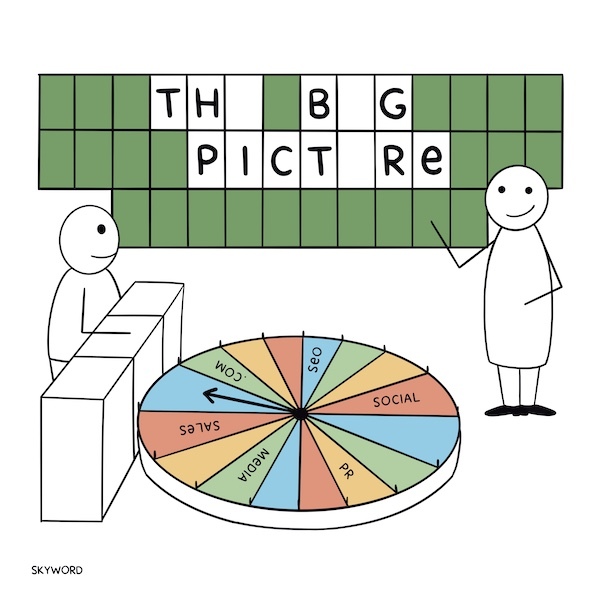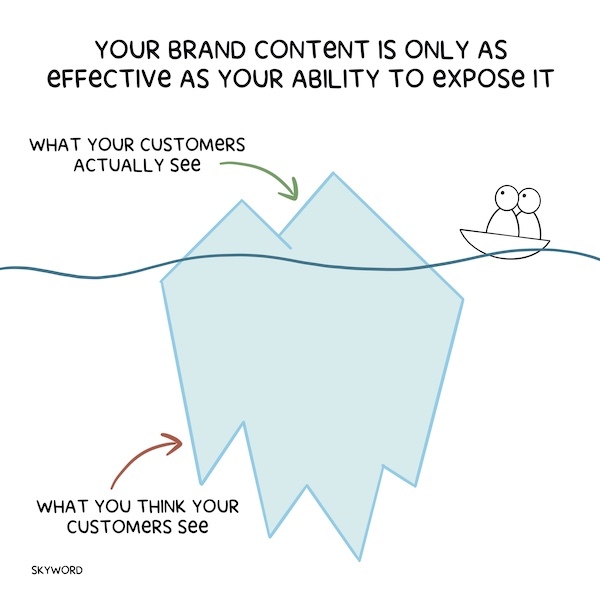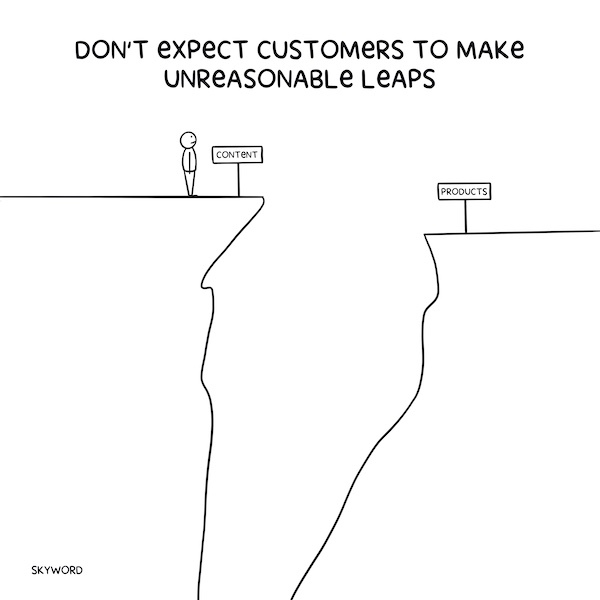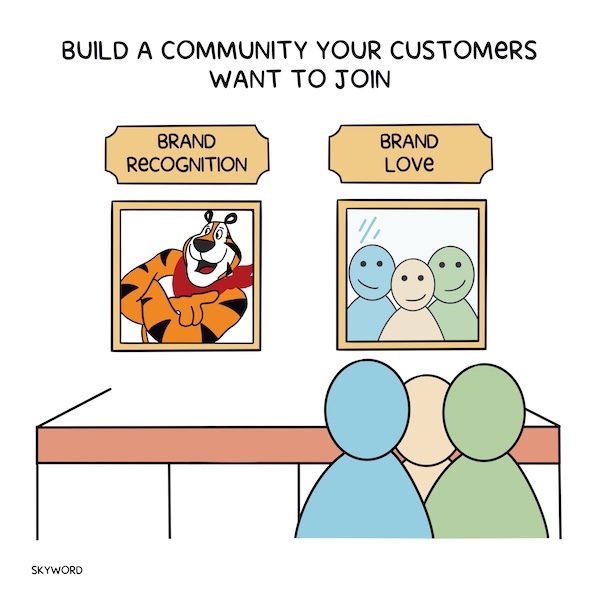Content Strategy
The Art of the Relationship: How to Know if Your Content Experience Is Meeting Customer Needs
By Andrew Wheeler on June 3, 2022
Subscribe to our monthly newsletter, Content & Context, to receive more insights and updates on the content marketing world from Skyword CEO, Andrew C. Wheeler.
There are no silver bullets in marketing. I know this from a career spent researching and testing countless marketing technologies, strategies, and tactics—none of which turned out to be The Thing to guarantee marketing success.
But there's one simple truth that remains steadfast, no matter how volatile and complex and overengineered the world of marketing gets:
Marketing is about building a relationship with your customers.
Great marketers know how to create great relationships. More specifically, they know how to use all the tools at their disposal to be the partner in that relationship that their customers need them to be.
Many of the marketers I've spoken with recently feel particularly untethered from this practice. They firmly believe in the concept, but it's hard to put a finger on what the customer relationship looks like anymore.
It's no surprise given today's operating environment. Marketing parameters have been redrawn since the pandemic; in the current economic climate, there's intense budget pressure and a legitimate fear of investing in the wrong things, and then, there's the looming and as-yet-unknown implications of Web3 and the metaverse…
Today, I hope to offer some clarity—an opportunity to zoom out and bring the big picture back into focus.

If you tuned in last month, I shared our latest research report that details what buyers want from brand experiences and the specific factors that most influence their purchase decisions.
To help you determine if your content is delivering against those needs, we've identified 7 key dimensions of your content experience to assess.
Think of these, collectively, as the litmus test for your brand's relationship-building skills and a blueprint for where to focus your efforts moving forward.
1. Presence
This encompasses where and how you're showing up for your customers. Like any relationship, one can't exist if you're never introduced. Look at your total content footprint and ask these questions to gauge if content is actually helping customers discover your brand on their terms.
Ask:
-
Do you publish original, informative content to the channels and platforms your customers are most likely to use? Is that content driving back to your owned properties?
-
Are you publishing consistently enough to maintain your brand's visibility on those platforms and channels?
-
Does your own website host useful content resources in a way that's easy for your customers to access?
-
What is the content saying about you as a brand? Is it mostly announcing and promoting, or is it mostly offering support/something of value?

2. Authority
This pertains to how effective you've been at establishing your brand as an industry leader and trustworthy partner. Turns out, buyers look for certain signals that indicate they're placing their money and energy in good hands before they purchase.
Ask:
-
Is content consistently focused on a specific set of topics your brand is uniquely qualified to advise on, or is it scattered?
-
Is content contributed by credible brand/industry/topic experts?
Is your content ranking highly in search for the key terms related to your solutions and areas of expertise?
3. Helpfulness
This considers the degree to which you're providing the information your customers actually want and need throughout the research and purchase process. To be a good partner, the vast majority of your marketing energy should be spent aligning content to your customers' concerns and decision-making process—not promoting your own agenda. This seems obvious, but brands often miss the mark in practice.
Ask:
-
Do you offer content that answers your customers' most frequently asked questions clearly and thoroughly?
-
Do you offer content that educates your customers about your market and/or make sense of the various solutions available to them?
-
Do you offer content that helps customers understand exactly how your solutions work and differ from similar offerings?
-
Do you offer content that helps customers confirm that your solutions have delivered positive results for others like them?
4. Connectivity
This is all about how you stage content to bring greater ease into the customer experience. More specifically, it's the degree to which you're removing friction, information overwhelm, and unnecessary steps from the buyer journey.
Ask:
-
Are you packaging content in a way that helps to combine or remove steps in the research and purchase process?
-
Do related assets connect to each other via crosslinks, recommendations, or on-page modules?
-
Are assets grouped by behavioral logic and customer intent or simply by topic?
-
Do assets that discuss challenges connect to assets that explain solutions in detail?
-
Does the content experience anticipate what your customers' next question or step might be and proactively point them toward the right information?

5. Relevance
This considers the degree to which your content aligns with customers as individuals who have distinct needs and challenges. Your content may have general appeal, but when customers drill-down, they want to feel heard, seen, and understood on a 1:1 basis.
Ask:
-
Is content clearly aligned to specific personas?
-
Is content organized so customers in a particular segment/industry/interest category can easily find information that's relevant to them?
-
Is zero-party data being collected and used to deliver dynamically personalized advice or experiences?
6. Differentiation
This considers the degree to which your content is uniquely valuable and differentiated. In most buyers' minds, differentiation and rarity are key indicators of product and brand value. The more you can communicate those qualities early in the purchase process, the more likely you are to convert visitors into buyers.
Ask:
-
Does the substance of your content stand out from similar information that can be found elsewhere in terms of its tone or the depth and utility of its insights?
-
Is content presented in a way that's polished, consistently branded, compelling, and easy to digest?
-
Beyond generic information, do you offer access to proprietary data or expertise that isn't easy for customers to come by elsewhere?
7. Community
This concerns the degree to which content is helping you build and promote a community your customers identify with and want to join. As humans, we crave belonging and connectedness. The brands that appeal to that tribal instinct are more likely to earn preference and buyer endorsements than those who don't.
Ask:
-
Is content used to nurture a community passive visitors can join/subscribe to?
-
Does your content demonstrate that you regularly engage with your audience and customers outside of a transactional context?
-
Is content used to engage that community, facilitate interaction between community members, or educate community members in an exclusive way?

If you answered "no" to a lot of these questions, you're not alone. Most brands are not operating at full throttle in all these areas at once. However, I encourage you to use this framework to identify the biggest gaps in your content experience and where there's the lowest-hanging fruit. Make the necessary changes, and the results will help you build momentum and gain buy-in as you systematically tackle the next front.
I hope this is a reassuring reminder that your marketing doesn't have to operate at the mercy of the latest tech. Lasting advantage actually comes from being rooted in the service of basic, steadfast psychological needs. Make those fundamentals the foundation you build on, and use whichever tech and tactics best suit your brand's chosen approach.
To learn more about our research and how you can apply this assessment to your content strategy, check out skyword.com/assessment. If you enjoyed this newsletter and think a colleague might benefit from it, I welcome you to forward it and encourage them to subscribe to receive future newsletters.
Featured image by </em>Hans-Peter Gauster on Unsplash.
